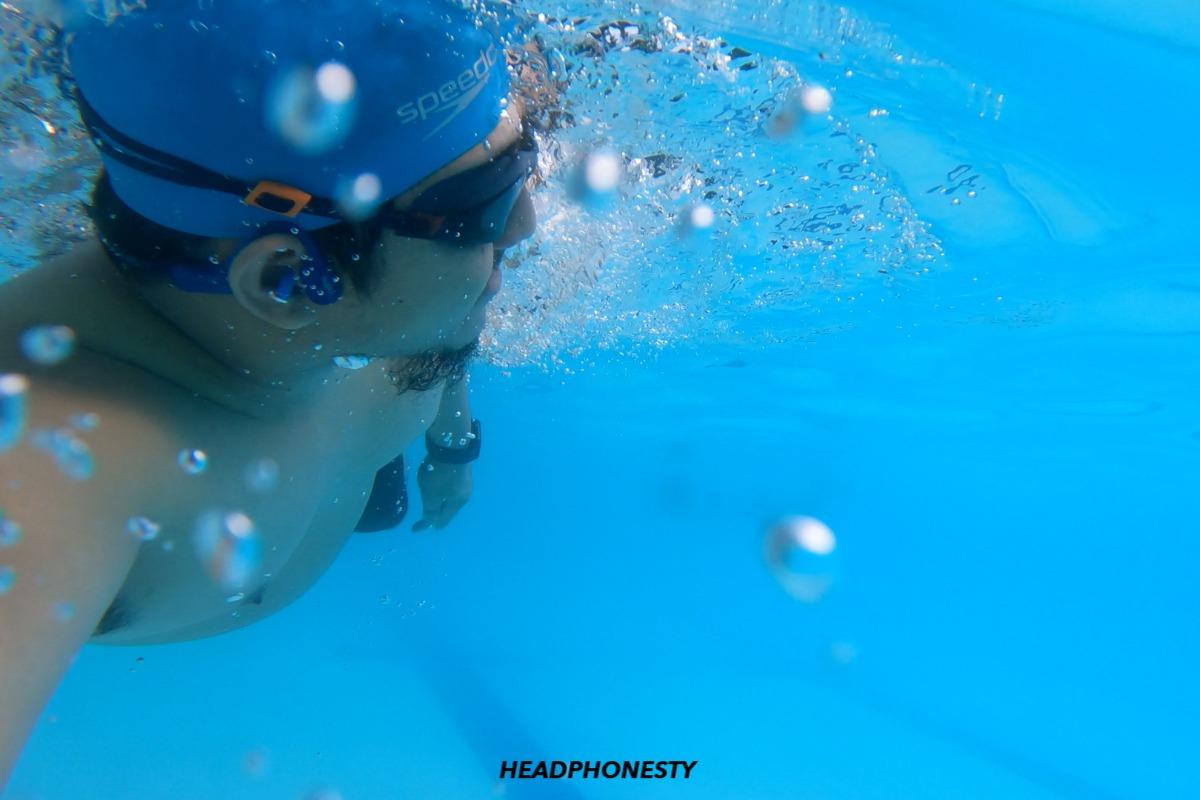The Shokz OpenSwim headphones are great for swimming, but perhaps nothing else.
- IP68 waterproof rating, perfect for swimming
- Different listening modes for on-land and underwater listening
- Comfortable, lightweight design compatible with standard swimming gear
- User-friendly controls for easy operation during swimming
- Built-in MP3 player with 4 GB storage can store up to 800 songs
- No battery gauge/level visible
- Fit may loosen during high-intensity swimming activities
- Bass-heavy genres sound muddy in General mode
- Uncomfortable when used on land
- No Bluetooth connectivity limits on-land versatility
Formerly known as the Aftershokz Xtrainer, the Shokz OpenSwim have already made a mark on their unique aquatic audio market. They combine bone conduction technology with a high IP68 waterproof rating, promising to be a robust companion for both leisurely and intense aquatic activities.
With a focus not on conventional audio delivery but on enhancing the swimming experience, the OpenSwim steps away from the norm. This raises a compelling question: how effectively does Shokz balance the unique demands of underwater audio with the expected clarity and comfort of high-quality headphones?
To answer this, I tested these headphones for three weeks and brought them into my regular swimming sessions on our community lap pool. Here’s what I found out:
Waterproofing
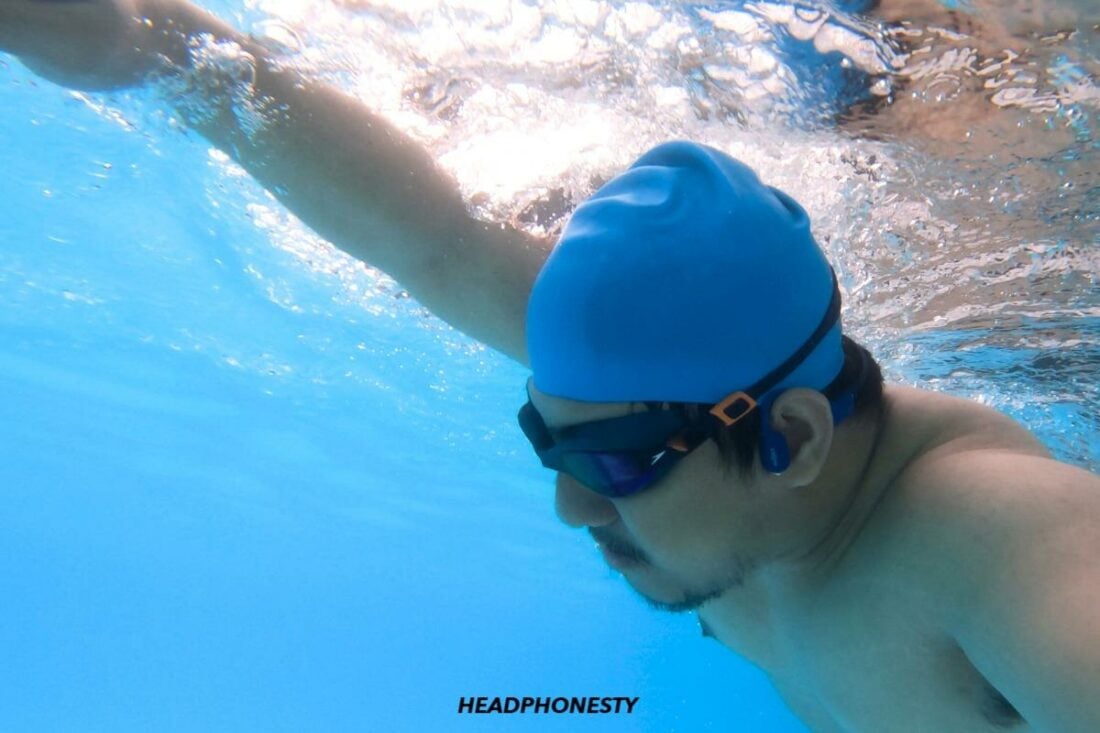
The Shokz OpenSwim headphones, boasting an IP68 rating, have proven to be a reliable companion for aquatic enthusiasts. Based on their IP rating, these headphones are fully protected against dust and any solid particles. They are also well-suited for use in typical swimming environments, such as lap swimming in Olympic-sized pools with an average depth of around 2 meters.
During my swimming sessions, the waterproofing of the Shokz OpenSwim proved to be impressive. The construction of the headset, lacking any visible holes or gaps, instills confidence in its ability to resist water ingress. This smooth design ensures that water seepage is not a concern, even during extended use in the pool.
I rigorously tested these headphones to gauge their durability and reliability underwater. They were submerged at depths of approximately 2 meters for durations of 1-2 hours during my initial swimming session.
During this session, what stood out was their consistent performance, irrespective of the depth and duration. Whether at 1 meter or 2 meters, for an hour or two, the Shokz OpenSwim maintained a steady performance level, showing no signs of water damage or functional decline.
Sound Quality
The Shokz OpenSwim headphones, with their 7th generation bone conduction technology, offer a nuanced sound experience both in and out of the water using their two listening modes: General and Swimming.
In the General mode, tailored for above-ground use, the headphones present a satisfactory bass that’s noticeable without being overpowering. This mode is particularly favorable for genres like indie music, where the balance between bass, midrange, and treble creates a pleasant listening experience.
However, bass-heavy genres like EDM or heavy metal might not sound as appealing, as the lower frequencies tend to become a bit muddy, especially if this mode is used underwater.
Switching to Swimming mode, intended for underwater use, the audio profile changes significantly. The bass and midrange are noticeably reduced, a design choice aimed to prevent a muddy mix underwater.
This mode emphasizes treble and high notes for clarity, making it ideal for underwater listening but not as suitable for above-ground use due to the lack of depth in bass and midrange.
Interestingly, I didn’t need much volume adjustments underwater. A volume level of 70-80% is already generally sufficient for clear and enjoyable listening. Lower volumes, on the other hand, tend to result in muffled sound, likely due to water pressure.
Comfort
Featuring a wraparound, behind-the-neck design, the Shokz OpenSwim headphones are astoundingly comfortable to wear, especially during extended swimming sessions. I tested these while swimming for over two hours and didn’t feel any discomfort.
The headphones felt almost non-existent, blending seamlessly into my activity without causing any distraction. This invisibility of sorts is primarily due to their lightweight material, which ensures that they don’t weigh down or create pressure points around the ears or neck.
However, it’s worth noting that the experience slightly shifts when you’re out of the water.
After about 2-3 hours of wearing them above ground, I did start to feel a bit of irritation where the headphones sling behind my neck. This discomfort wasn’t overwhelming but was noticeable, particularly for someone like me who isn’t accustomed to this specific style of headphones.
Fit
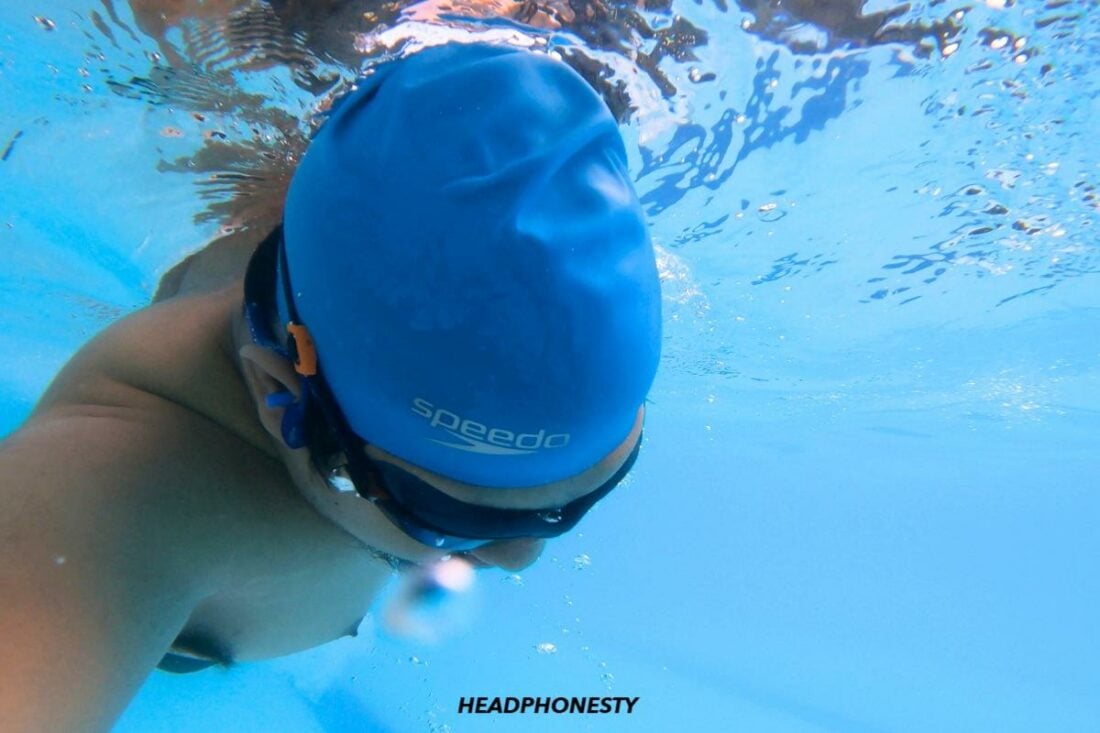
The Shokz OpenSwim headphones excel in fitting seamlessly with standard swimming gear, such as caps and goggles. I encountered no issues of interference or discomfort, indicating a thoughtful design for aquatic use.
The slight wobble noticed on land is absent underwater, further emphasizing their stability in their intended environment.
Plus, as I experimented with different swimming strokes and increased my pace, the headphones adapted well, particularly at lower to medium intensities.
Sure, there was a slight loosening when I pushed to a higher pace, but I found a simple fix by securing the top part of the headset with my swimming cap. While this might affect comfort for some, it didn’t bother me much and seemed a small compromise for the stability it provided.
Overall, my time with the Shokz OpenSwim headphones was quite positive. Their design, stability, and compatibility with swimming gear make them a solid choice for swimmers who want to enjoy audio in the water without the hassle of constantly adjusting their headphones.
Durability
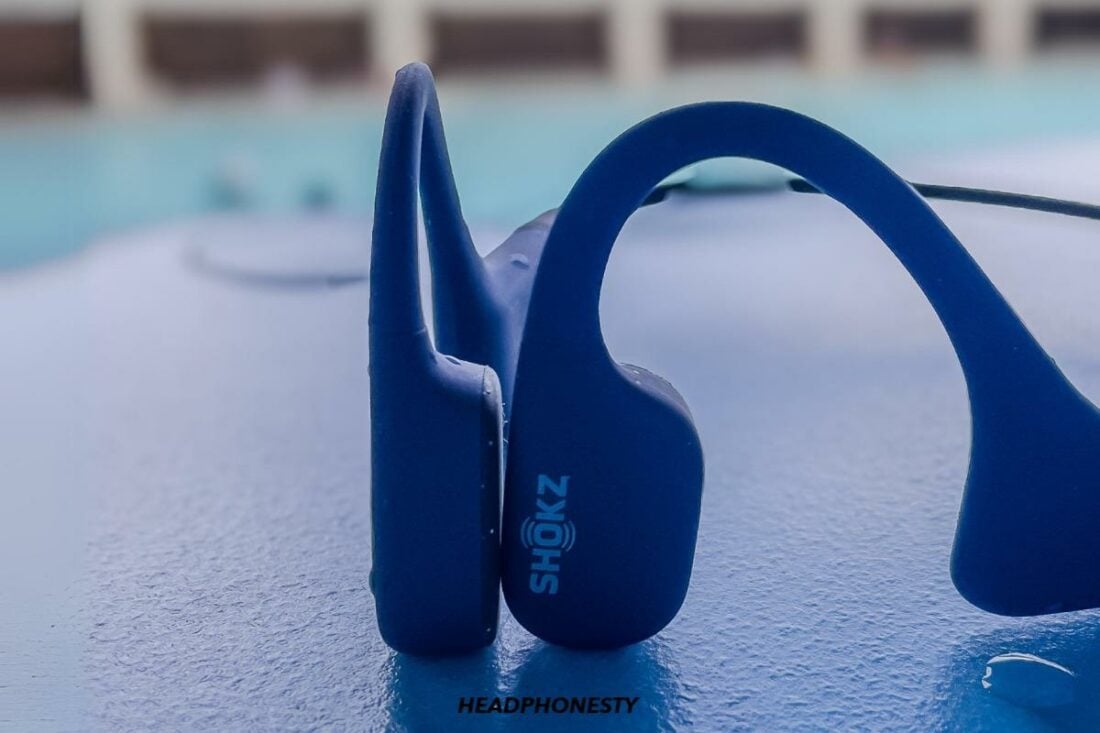
The first thing that struck me in terms of durability was the premium feel of the headphones. The rubberized covering, a common feature in swimming gear, gave it a sense of belonging in the pool environment. This material choice not only contributes to the aesthetic but also plays a vital role in the durability of the product.
The combination of aluminum construction and rubberized exterior also suggests that these headphones can survive numerous falls and rough handling. During my time using them, they felt robust and capable of withstanding the typical wear and tear associated with regular swimming sessions.
I also didn’t noticed any significant signs of deterioration like color fading, cracking, or peeling. However, after prolonged exposure to pool water, I observed some white powdery artifacts, which I suspect might be due to the chlorine. This is something users should be aware of, as it could affect the long-term appearance of the headphones.
Maintenance and cleaning of these headphones are remarkably straightforward, which is a huge plus. Post-swim, there’s no need for elaborate cleaning routines. Like many rubberized swimming accessories, they can simply be placed in their pouch, and they’ll dry on their own.
Battery
My experience with these headphones aligns well with the manufacturer’s claim of 8 hours of battery life. During my typical 1-2 hour swimming sessions, I found that a single charge lasted for about three sessions, without the need for a recharge in between.
This is quite impressive and indicates that for casual listeners like myself, who can’t use headphones continuously for 8 hours due to work commitments, the OpenSwim can comfortably provide 2-3 days of use.
The charging time for these headphones is another highlight. It takes approximately 2 hours to fully charge, which then translates to 8 hours of usage.
This charging duration, while not too outstanding, fits seamlessly into my routine, as I rarely run out of battery. On the off chance that I do, the ability to quickly charge the headset with a power bank adds a layer of convenience that I appreciate.
Additionally, Shokz has integrated a thoughtful feature to conserve battery life. The headset automatically powers down after an hour of idleness, which is a smart way to preserve the battery when not in active use.
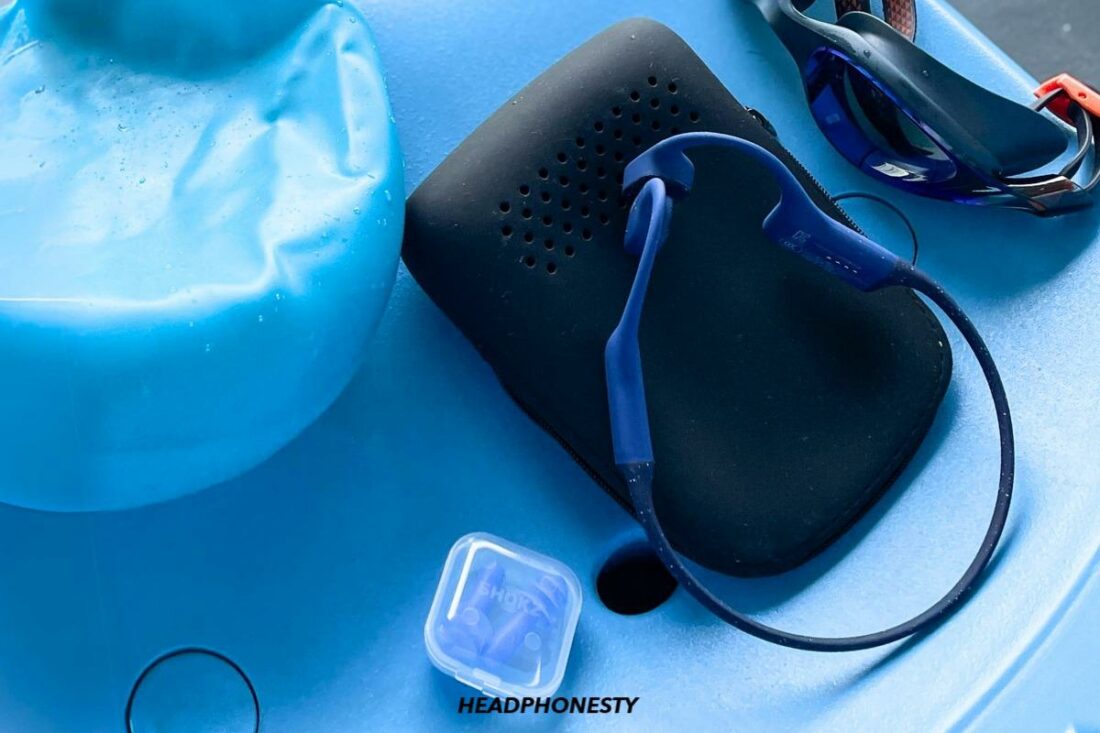
However, one area that could see improvement is the method of informing users about the remaining battery life. Currently, the only indication of a low battery comes from a voice notification when the headset is close to being completely discharged. This means there’s no direct way to check the battery level during a swim, which can be a bit inconvenient.
UX
In terms of intuitiveness, OpenSwim’s controls are straightforward and easy to operate. Adjusting the volume, skipping tracks, or pausing music can be done with minimal effort. This ease of use is crucial when you’re in the middle of a swim and prefer not to stop your flow.
That said, certain functions like enabling the “Shuffle mode” do require a brief pause, as it requires holding down a button for about 5 seconds.
The controls have also held up remarkably well against constant exposure to water and chlorine. I haven’t noticed any wear or deterioration in the controls over time. I also didn’t encounter any issues like accidental triggers on the controls.
However, there don’t seem to be any special control features specifically tailored for swimmers. Standard controls are provided without additional enhancements for underwater use, which is a missed opportunity for further refinement.
But the most frustrating part is familiarizing myself with the small-sized buttons and their placement. Initially, finding and pressing the correct button can be a bit challenging, especially when you’re focused on your swim. Over time, though, this becomes less of an issue as muscle memory kicks in.
Audio Playback Options
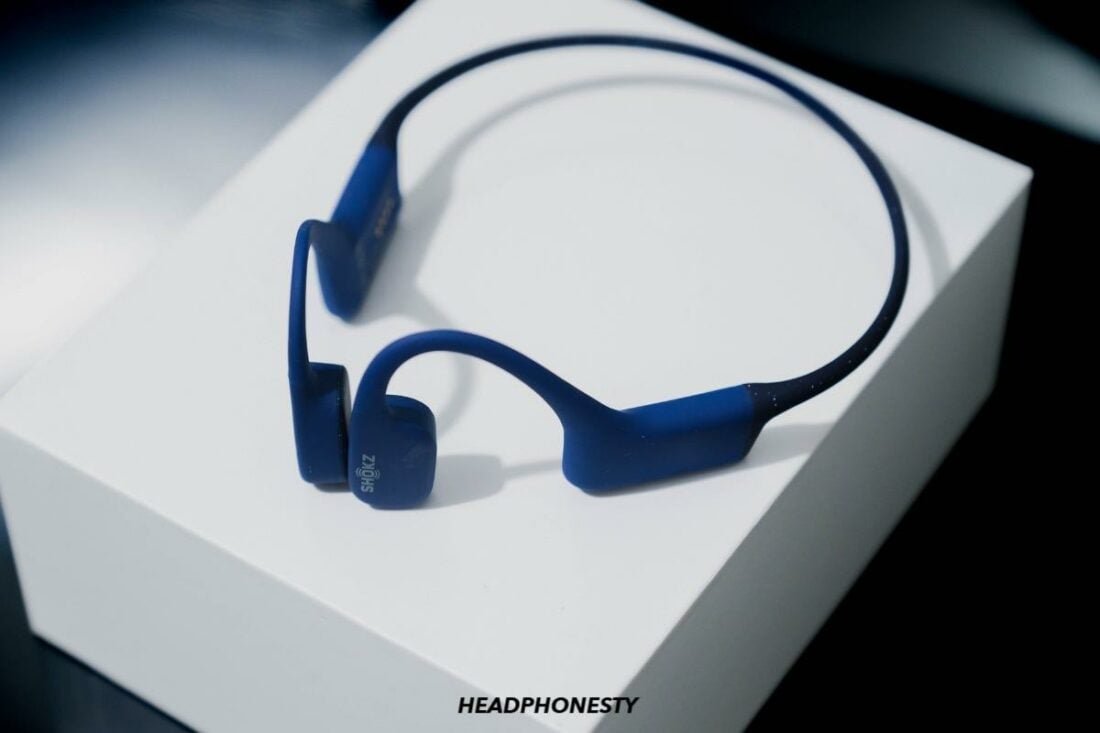
The Shokz OpenSwim headphones’ built-in MP3 player works best for swimmers, as other wireless options like Bluetooth won’t work well underwater.
The good news is, loading music onto the built-in MP3 player of my Shokz OpenSwim headphones is incredibly straightforward and convenient. The drag-and-drop operation for transferring music files is as simple as moving files onto a USB drive.
However, the challenge I faced was primarily about sourcing the actual MP3 files of my favorite songs.
With the dominance of streaming services like Spotify and Apple Music, finding downloadable MP3 files, especially for popular songs, has become more complex due to copyright and piracy concerns. I had to find ways to legally obtain MP3 files (without spending much), which required a bit more effort.
In terms of compatibility, I find that these headphones work well with various devices, such as PCs and Macs. However, I have noticed some difficulty when trying to load music from a mobile phone, which is something to consider if you primarily use your phone for music.
The 4 GB storage capacity of the OpenSwim is quite impressive. Based on my calculations, assuming each MP3 file is about 5MB, this allows me to store roughly 800 songs. This is more than enough for my swimming playlists, ensuring a wide variety of music for my sessions.
As for the playback quality, I haven’t noticed any significant differences between the various supported formats like MP3, WAV, WMA, AAC, and FLAC. The key factor here is the source quality of the audio file. I’ve learned that a bad copy or overly compressed file can greatly affect the song quality, regardless of the format.
Who Should Buy This
The Shokz OpenSwim headset is ideal for casual or recreational swimmers, especially those who engage in long, leisurely swims of 5 kilometers or more. The great waterproofing capacity, along with intuitive controls, comfortability, and decent underwater sound quality, can help make their long swims more enjoyable.
However, those seeking a versatile headset for both swimming and regular on-land use might find the OpenSwim’s lack of features like Bluetooth connectivity limiting for everyday listening needs.
Final Thoughts
As an avid swimmer, my experience with the Shokz OpenSwim headphones was largely positive. Their IP68 rating is a standout feature, guaranteeing complete dustproof and waterproof protection, which gave me peace of mind during my pool sessions.
While swimming, they were remarkably comfortable and light, blending seamlessly with my activities. They fit well with my swimming gear, staying securely in place, particularly when tucked under my swim cap during intense laps.
In essence, for swimmers looking for a dedicated, waterproof audio solution, the Shokz OpenSwim headphones are a solid choice.
However, they are not as great when used outside of the swimming pool. While there’s a General listening mode that offers a decent audio experience on land, the headphones tend to struggle with heavier bass tracks. This becomes particularly noticeable with genres like EDM or heavy metal, where the bass can feel muddy, diluting the overall audio experience.
After a few hours on land, I also started to feel some irritation where the headphones wrapped around my neck. This is a stark contrast to the almost unnoticeable feel they have in the water. Moreover, the lack of features like Bluetooth connectivity restricts their versatility, limiting their appeal for those seeking a multi-environment audio device.
Where to Buy
What’s in the Box?
- OpenSwim Headphones
- Charger cradle
- Warranty Card with serial number
- Manual and instructions
- Silicone Rubber Case
- Swimming Earplugs
Technical Specifications
- Form: Bone conduction headphones
- Driver: 7th Generation Bone Conduction technology
- Waterproof IP Rating: IP68
- Weight (g): 30g
- Battery Life (hrs): 8 Hours
- Charge time: 2 hours
- Built-in MP3: Yes
- Compatible Profiles: MP3, WMA, FLAC, WAV, AAC
- Bluetooth: N/A
- Materials: Full Titanium
- Frequency response: 20 Hz-20 KHz
- Sensitivity: 96 ± 3dB
- Mic: N/A
